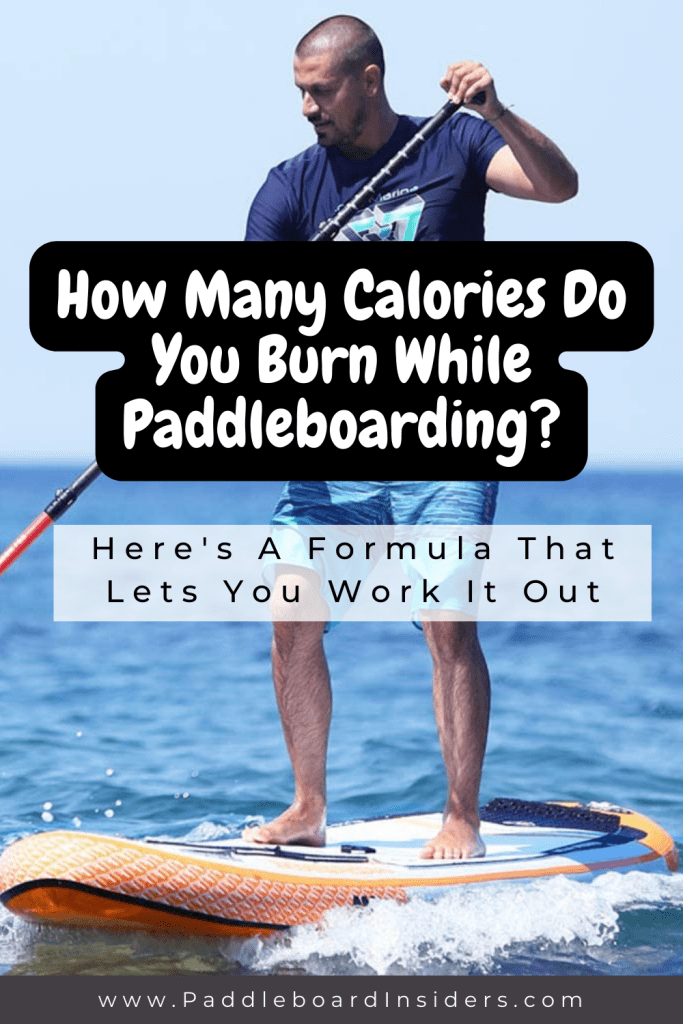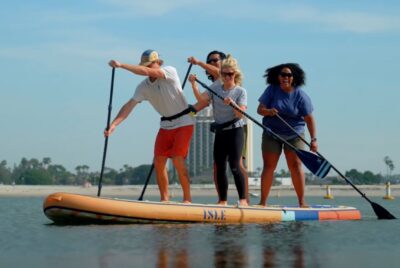A Simple Formula To Calculate How Many Calories You Burn Paddle Boarding
Paddleboarding has gained immense popularity in recent years, and for good reason. It offers a unique blend of adventure, tranquility, and fitness benefits. Many enthusiasts wonder, “How many calories are burned when paddleboarding?” If you’re curious about the calorie-burning potential of this activity, you’re in the right place.
Here’s the low down:
- Estimated calories for recreational paddleboarding = 300-430 calories per hour
- Estimated calories for fitness paddleboarding = 450-650 calories per hour
- Estimated calories for competitive paddleboarding = 700-1000 calories per hour
But you might not know that there’s actually a formula for figuring this out. Keep reading to find it out.
| Looking for our best paddle board product recommendations? Check the Paddleboard Insiders Buyer Guides |
How Many Calories Do You Burn While Paddle Boarding?
Now, let’s address the factors that influence the number of calories burned using a stand up paddle board. It’s essential to understand these variables to get a more accurate estimate of your calorie expenditure.
Body Weight
Your body weight plays a crucial role in determining the number of calories burned. Generally, individuals with higher body weight burn more calories than those with lower body weight due to the increased effort required to paddle and move the board.
Intensity of Paddleboarding
The intensity of your paddleboarding session also affects calorie burn. Paddleboarding at a leisurely pace burns fewer calories compared to engaging in a vigorous paddle or incorporating interval training with the intention of losing calories.
Duration of Paddleboarding
The duration of your paddleboarding session directly impacts the calorie burn. Longer sessions naturally result in higher calorie expenditure. However, even shorter bursts of intense paddling can provide a significant calorie-burning boost.
Awesome, so now that that’s out of the way, let’s talk about…
How Do You Calculate Calories Burned Paddleboarding?
Let’s explore some calorie burn estimates for different paddleboarding activities. Please note that these numbers are approximate and can vary depending on individual factors.
Paddleboarding for Recreation
During a leisurely paddleboarding session, you can expect to burn around 300-430 calories per hour, depending on factors such as body weight and effort level. It’s an excellent way to enjoy the water while still getting a moderate workout.
| Estimated calories for recreational paddleboarding = 300-430 calories per hour |

Paddleboarding for Fitness
If you’re looking to elevate your workout and burn more calories, you can increase the intensity of your paddleboarding session. Engaging in a more vigorous paddle, incorporating interval training, or trying out paddleboarding yoga can elevate your calorie burn to around 450-650 calories per hour.
| Estimated calories for fitness paddleboarding = 450-650 calories per hour |

Paddleboarding Races and Competitions
For those seeking a competitive edge, paddleboarding races and competitions are exhilarating challenges. These high-intensity events can result in calorie burns of 700-1,000 calories per hour or more, depending on the race’s length and difficulty level.
| Estimated calories for competitive paddleboarding = 700-1000 calories per hour |

The Perfect Calories Burned Paddleboarding Formula:
If you want to be able to calculate the number of calories burned per minute of paddleboarding then you can use the following formula.
| Calories burned per minute paddle boarding = (MET x body weight in Kg x 3.5) ÷ 200 |
if you prefer pounds to kilograms, use the following formula:
| Calories burned per minute paddle boarding = (MET x (body weight in pounds ÷ 2.205) x 3.5) ÷ 200 |
How To Use The Formula Properly:
MET = Metabolic equivalent and this refers to how much energy is required to perform a certain activity
A MET of 1 equates to very low levels of activity, like sitting still just watching TV. Walking at a moderate pace is equivalent to a MET level of 3. Higher levels of exertion begin at a MET level of 4.
An intermediate paddle boarder’s exertion level will equal a MET level 6. Vigorous, racing paddling can go as high as level 10.
So a 70kg (154 lbs) person can calculate their calories burned per minute as follows.
| Intensity Level: | Calculation: | Calories Per Minute: |
| Low Intensity: | (2x70x3.5)/200 | 2.45 Calories |
| Medium Intensity: | (2x70x3.5)/200 | 7.35 Calories |
| High Intensity: | (10X70X3.5)/200 | 12.25 Calories |
What is Paddleboarding?
Paddleboarding, also known as stand-up paddleboarding (SUP), involves standing or kneeling on a board and propelling oneself forward using a paddle. It’s a versatile water sport that can be enjoyed on lakes, rivers, and even ocean waves. Whether you prefer leisurely exploration or an intense workout, paddleboarding caters to all fitness levels and interests.
Health Benefits of Paddleboarding
Before we delve into the specifics of calorie burn, let’s explore the numerous health benefits that paddleboarding offers. Engaging in this activity regularly can have a transformative impact on your physical and mental well-being.
Cardiovascular Workout
Paddleboarding provides an excellent cardiovascular workout, elevating your heart rate and improving overall cardiovascular health. The continuous paddling motion engages large muscle groups, making it an effective way to strengthen your heart and lungs.
Muscle Strengthening
Maintaining balance and stability on a paddleboard engages various muscle groups, including the core, legs, arms, and back. The constant paddling action targets your shoulders, triceps, and chest muscles, resulting in improved strength and toning.
Improved Balance and Core Strength
One of the remarkable benefits of paddleboarding is its impact on balance and core strength. Staying upright on an unstable surface requires constant engagement of your core muscles, enhancing stability and posture.
Stress Relief
Immersing yourself in the serene beauty of nature while paddleboarding can significantly reduce stress levels. The rhythmic movement, combined with the calming effects of water, creates a peaceful and meditative experience that rejuvenates the mind and body.
Tips for Maximizing Calorie Burn while Paddleboarding:
To make the most of your paddleboarding workouts and optimize calorie burn, consider implementing the following tips:
Maintain Proper Form
Focus on maintaining a good paddling technique and posture. Engage your core muscles, maintain a straight back, and use your entire body to generate power. This ensures efficient paddling and maximizes calorie expenditure.
Increase Intensity with Interval Training
Incorporate interval training into your paddleboarding routine. Alternate between bursts of high-intensity paddling and periods of active recovery. This method can significantly enhance your calorie burn and overall fitness.
Incorporate Resistance Training
Take advantage of resistance training during your paddleboarding sessions. Engage in exercises such as squats, lunges, and push-ups on the board to work additional muscle groups and increase calorie expenditure.
Explore Different Paddleboarding Techniques
Don’t limit yourself to a single paddleboarding style. Experiment with different techniques like touring, surfing, and racing. Each style offers a unique challenge and engages different muscle groups, leading to diverse calorie burns.

Other Considerations
Before you hit the water, keep in mind these additional considerations to ensure a safe and enjoyable paddleboarding experience:
Wind and Currents
Be mindful of wind conditions and water currents, as they can affect the difficulty and calorie burn of your paddleboarding session. Paddling against strong winds or challenging currents can provide an extra workout boost.
Make sure that you look at the weather conditions before you go out onto the water to make sure that you are aware of the conditions.
Paddleboarding Accessories
Investing in the right paddleboarding accessories can enhance your performance and comfort. Grab a great paddleboard, use a lightweight, adjustable paddle and wearing proper footwear for stability. These accessories can help you paddle more efficiently and extend your sessions.
| Here are my favorite paddle boarding accessories in 2025: The 23 Best Paddleboard Accessories That You Need In 2025 |
Safety Precautions
Always prioritize safety during your paddleboarding adventures. Wear a personal flotation device (PFD), familiarize yourself with local water regulations, and check weather conditions before heading out. Safety should be your top priority while enjoying this incredible activity.
How Hard Should You Inflate A Paddle Board?

- Most paddle boards should be inflated between 12 – 15 pounds per square inch (PSI).
- As a rule of thumb – 15 psi is a safe inflation for most paddle boards provided that the temperature is less than 25 degrees celsius (77 degrees fahrenheit).
- If weigh more than 90 kilograms (198 lbs) then you will be safe inflating to maximum 18 psi, but you should not exceed that.
- Most paddle boards are tested in laboratory conditions up to 20 psi so using 18 psi as a maximum is a safe bet.
Conclusion: Calories Burned Paddleboarding
Paddleboarding offers a fantastic opportunity to combine adventure, fitness, and tranquility. When it comes to calories burned paddleboarding – you can get a moderate to high-intensity workout, depending on your effort level and technique. Remember to consider your body weight, intensity of paddleboarding, and duration of the session to estimate your calorie expenditure accurately.
So, why not grab a paddleboard, head out onto the water, and embrace the benefits of this exhilarating sport? Experience the joy of gliding across the water while improving your cardiovascular fitness, toning your muscles, and enjoying the serenity of nature.
| Looking for insider guides to some amazing paddle boarding locations? Check the Paddleboard Insiders Location Guides |
FAQs
Can paddleboarding help with weight loss?
Absolutely! Paddleboarding is an excellent activity for weight loss as it engages various muscle groups and burns calories. Combine it with a balanced diet for optimal results.
Is paddleboarding suitable for beginners?
Yes, paddleboarding is beginner-friendly. Start with calm waters and practice balancing on the board before progressing to more challenging conditions.
Can I paddleboard if I don’t know how to swim?
It’s highly recommended to know how to swim before attempting paddleboarding. While wearing a PFD is essential, having swimming skills ensures your safety in case of any unforeseen circumstances.
What should I wear while paddleboarding?
Opt for comfortable clothing that allows freedom of movement. Consider wearing a rash guard or sunscreen for sun protection and a hat to shield your face from the sun. For more information on what to wear, read this article.
Can paddleboarding be done in the winter?
Yes, paddleboarding can be enjoyed year-round. In colder months, wear a wetsuit or drysuit to stay warm and ensure proper insulation.
Remember, paddleboarding is not just a workout; it’s a lifestyle that offers countless physical and mental health benefits. So, grab your board, paddle into the water, and let the journey begin!





